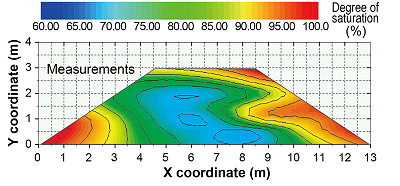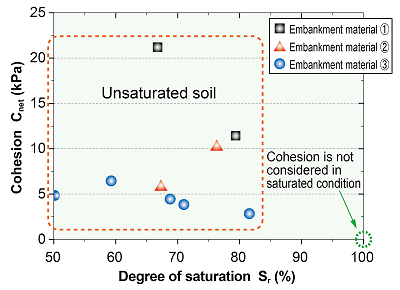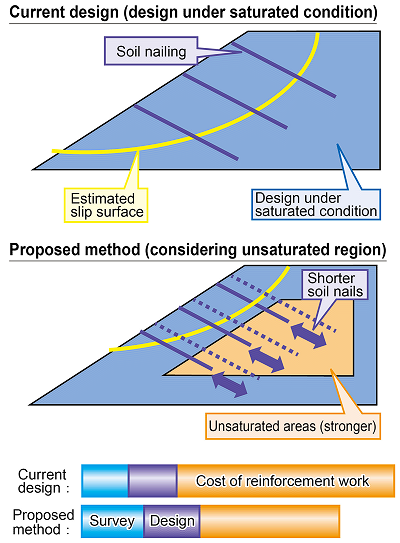24. Seismic resistance design method considering unsaturated condition of embankments
Over the past few years, progress has been made in antiseismic reinforcement of embankments, however, existing design methods for antiseismic reinforcement are based on designs using the results of strength tests on saturated embankment materials. Consequently, there is a dearth of seismic evaluations and much work still has to be done in the field of reinforcement.
The water content inside an actual embankment affected by rainfall was therefore measured over a long period of time. These measurements confirmed the unsaturated state of parts of the embankment and that it was possible to reproduce the behavior of the embankment through seepage analysis (Fig. 1).
Strength tests on unsaturated embankment material demonstrated that cohesion was greater than when the embankment was saturated (Fig. 2).
A design method for antiseismic reinforcement considering the unsaturated condition of an embankment was proposed on the basis of this outcome, and a manual was produced setting out the prerequisite conditions, surveying methods and laboratory test and design methods.
Subsequently the proposed method was compared with the existing evaluation method. The outcome showed that the required soil nails could be shortened, reducing the whole cost of work by approximately 20% compared to designs based on the existing method (Fig. 3).
Other Contents
- 24. Seismic resistance design method considering unsaturated condition of embankments
- 25.Method for estimating bridge maintenance indicators by combining measured and analytical values
- 26.Quantitative evaluation of the impact force on a bogie due to a wheel flat
- 27.Simulation of hot gas in tunnel fires
- 28.Development of work-place decision-making tasks to assess decision-making skills
- 29.Demonstration of vibration resistance and magnetomotive force of Yttrium-Barium-Copper-Oxide high temperature superconducting coil
- 24. Seismic resistance design method considering unsaturated condition of embankments
- 25.Method for estimating bridge maintenance indicators by combining measured and analytical values
- 26.Quantitative evaluation of the impact force on a bogie due to a wheel flat
- 27.Simulation of hot gas in tunnel fires
- 28.Development of work-place decision-making tasks to assess decision-making skills
- 29.Demonstration of vibration resistance and magnetomotive force of Yttrium-Barium-Copper-Oxide high temperature superconducting coil



